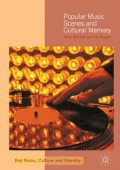Abstract
Since the early 1990s, the concept of scene has gathered critical momentum as a means of studying the intersection of music and everyday life. A centrally important feature of scene theory has been its rejection of purely structural accounts of musical taste and a move away from associated conceptual frameworks such as ‘subculture’ and ‘community’. In its conceptual transgression, scene has also contributed to the recasting of collective musical participation as something that can transcend the physical parameters of space and place to take on more affective and trans-local qualities (Straw 1991; Bennett and Peterson 2004). Similarly, with the emergence and increasing sophistication of digital media, there has been a growing acknowledgement in academic work on scenes of the potential for ‘virtual’ forms of scene activity, either as distinctive practices or interlaced with more traditional forms of face-to-face interaction (Bennett 2002; Lee and Peterson 2004). The focus on scenes in the present has ultimately led to a broadening of the scenes perspective to consider the historical and trans-temporal dimensions of music scenes. Important points of departure here have been emergent literatures on music and ageing (see, for example, Bennett 2013) and music and heritage (see, for example, Cohen et al. 2015). Between them, these literatures have illustrated the extent to which the popular music culture of the last 60 years has shaped generational identity and memory.
Access this chapter
Tax calculation will be finalised at checkout
Purchases are for personal use only
References
Bennett, A. (2002). ‘Music, media and urban mythscapes: A study of the Canterbury sound’. Media, Culture and Society, 24(1): 107–20.
Bennett, A. (2013). Music, Style and Aging: Growing Old Disgracefully? Philadelphia, PA: Temple University Press.
Bennett, A. and Peterson, R.A. (eds) (2004). Music Scenes: Local, Translocal and Virtual, Nashville, TN: Vanderbilt University Press.
Chaney, D. (1994). The Cultural Turn: Scene Setting Essays on Contemporary Cultural History. London: Routledge.
Cohen, S., Knifton, R., Leonard, M. and Roberts, L. (eds) (2015). Sites of Popular Music Heritage. London: Routledge.
Davidson, J., Bondi, L. and Smith, M. (eds) (2007). Emotional Geographies. Aldershot: Ashgate.
Erll, A. and Nünning, A. (eds) (2008). Cultural Memory Studies: An International and Interdisciplinary Handbook. Berlin: Walter de Gruyter.
Jansen, B. (2009). ‘Tape cassettes and former selves: How mix tapes mediate memories’. In K. Bijserveld and J. van Dijck (eds), Sound Souvenirs: Audio Technologies, Memory and Cultural Practices. Amsterdam: Amsterdam University Press.
Lee, S. and Peterson, R.A. (2004). ‘Internet-based virtual music scenes: The case of P2 in alt.country music’. In A. Bennett and R.A. Peterson (eds), Music Scenes: Local, Translocal, and Virtual. Nashville, TN: Vanderbilt University Press, pp. 187–204.
Olick, J.K and Robbins, J. (1998). ‘Social memory studies: From “collective memory” to the historical sociology of mnemonic practices’. Annual Review of Sociology, 24: 105–40.
Roediger III, H.L. and Wertsch, J.V. (2008). ‘Creating a new discipline of memory studies’. Memory Studies, 1(1): 9–22.
Smith, R. and Maughan, T. (1998). ‘Youth culture and the making of the post-Fordist economy: Dance music in contemporary Britain’. Journal of Youth Studies, 1(2): 211–28.
Stahl, G. (2004). ‘“It’s like Canada reduced”: Setting the scene in Montreal’. In A. Bennett and K. Kahn-Harris (eds), After Subculture: Critical Studies in Contemporary Youth Culture. Basingstoke: Palgrave Macmillan.
Straw, W. (1991). ‘Systems of articulation, logics of change: Communities and scenes in popular music’. Cultural Studies, 5(3): 368–88.
Author information
Authors and Affiliations
Copyright information
© 2016 The Author(s)
About this chapter
Cite this chapter
Bennett, A., Rogers, I. (2016). Introduction: Scenes and Memory. In: Popular Music Scenes and Cultural Memory. Pop Music, Culture and Identity. Palgrave Macmillan, London. https://doi.org/10.1057/978-1-137-40204-2_1
Download citation
DOI: https://doi.org/10.1057/978-1-137-40204-2_1
Published:
Publisher Name: Palgrave Macmillan, London
Print ISBN: 978-1-137-40203-5
Online ISBN: 978-1-137-40204-2
eBook Packages: Literature, Cultural and Media StudiesLiterature, Cultural and Media Studies (R0)

